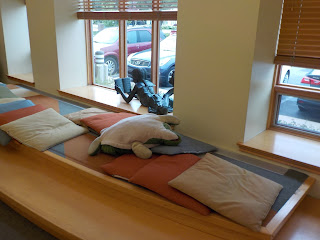Dresser was my second stop on this trip, and I was surprised when my gps indicated that it is only about five miles from Osceola. I think this demonstrates how important libraries are to their communities. In a way, it reminds me of the Hayfield, MN, library, but with some important differences. The similarity? We WILL have a library in our community. Differences? Hayfield is all-volunteer, Dresser has a library director. Hayfield is independent, not connected to any library cooperative, and Dresser is part of the MORE system in Wisconsin. But never mind all that, let's visit.
Here is the bright and festive Dresser Village Library...
...with its welcoming door.
Usually I introduce myself to someone who is staffing a service desk. I provide information about the blog and ask for permission to take interior pictures--without people in them. Once in a while I am immediately offered a tour. This can be a mixed blessing; sometimes it means that I see things I might have missed on my own, and sometimes I get caught up in the tour and forget to take notes...or pictures. Here in Dresser, I had the best of both worlds. First, Library Director Amber offered a tour, and I did indeed see things I might have missed. And then she "turned me loose" to look around on my own. It added up to a very nice visit.
There are three Internet computers available for public use; the third one in the row was indeed being used. The adult fiction section is full, and is subjected to regular weeding, an unpleasant but necessary task for any library. There is a sizable collection of large print books, but the audience for these books seems to be dwindling. One thing I would have missed on my own is a back room with copy, print, and fax equipment.
One corner of the children's area includes this "gears" manipulative and a door painted with chalkboard paint. Those of us who remember classroom blackboards remember the difficulty of getting them really clean (unless the teacher used a wet sponge) and the fun of "clapping the erasers" outside the door (while breathing chalk dust into our youthful lungs). But it's still fun to have a chalkboard available as a creative outlet.
What looks like quite a small library at first turns out to have a labyrinthine set of rooms. This is where my tour guide came in handy. However, I also could have followed the yellow-tape road, created by the librarian's daughter for the edification of people who seldom ventured beyond the first room.
The children's collection includes many popular series. Children's books, including fiction, are shelved by categories, similarly to the way they would be shelved in a bookstore. I'm still not comfortable with this system, though I'm seeing more and more often. It's not only the choice of small libraries; I think the first place I saw it was in Rochester, MN, where it was just being phased in for non-fiction.
This room also includes the Young Adult collection.
Other features of the children's area on the day I visited were this dinosaur display by the window and the friendly round table ready for four kids to read, color, or play.
The Dresser Village Library is an example of a small library striving to meet the needs of a changing population. I wish them well.
11/29/2017
































































